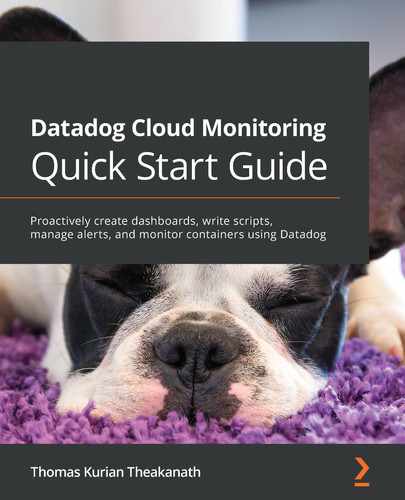A comprehensive guide to rolling out Datadog to monitor infrastructure and applications running in both cloud and datacenter environments Datadog is an essential cloud monitoring and operational analytics tool which enables the monitoring of servers, virtual machines, containers, databases, third-party tools, and application services. IT and DevOps teams can easily leverage Datadog to monitor infrastructure and cloud services, and this book will show you how. The book starts by describing basic monitoring concepts and types of monitoring that are rolled out in a large-scale IT production engineering environment. Moving on, the book covers how standard monitoring features are implemented on the Datadog platform and how they can be rolled out in a real-world production environment. As you advance, you'll discover how Datadog is integrated with popular software components that are used to build cloud platforms. The book also provides details on how to use monitoring standards such as Java Management Extensions (JMX) and StatsD to extend the Datadog platform. Finally, you'll get to grips with monitoring fundamentals, learn how monitoring can be rolled out using Datadog proactively, and find out how to extend and customize the Datadog platform. By the end of this Datadog book, you will have gained the skills needed to monitor your cloud infrastructure and the software applications running on it using Datadog. This book is for DevOps engineers, site reliability engineers (SREs), IT Production engineers, software developers and architects, cloud engineers, system administrators, and anyone looking to monitor and visualize their infrastructure and applications with Datadog. Basic working knowledge of cloud and infrastructure is useful. Working experience of Linux distribution and some scripting knowledge is required to fully take advantage of the material provided in the book.Key Features
Book Description
What you will learn
Who this book is for
Table of Contents
- Datadog Cloud Monitoring Quick Start Guide
- Contributors
- About the author
- About the reviewer
- Preface
- Section 1: Getting Started with Datadog
- Chapter 1: Introduction to Monitoring
- Technical requirements
- Why monitoring?
- Proactive monitoring
- Implementing a comprehensive monitoring solution
- Setting up alerts to warn of impending issues
- Having a feedback loop
- Monitoring use cases
- All in a data center
- Application in a data center with cloud monitoring
- All in the cloud
- Monitoring terminology and processes
- Host
- Agent
- Metrics
- Up/down status
- Check
- Threshold
- Monitor
- Alert
- Alert recipient
- Severity level
- Notification
- Downtime
- Event
- Incident
- On call
- Runbook
- Types of monitoring
- Infrastructure monitoring
- Platform monitoring
- Application monitoring
- Business monitoring
- Last-mile monitoring
- Log aggregation
- Meta-monitoring
- Noncore monitoring
- Overview of monitoring tools
- On-premises tools
- SaaS solutions
- Cloud-native tools
- Summary
- Chapter 2: Deploying the Datadog Agent
- Technical requirements
- Installing the Datadog Agent
- Runtime configurations
- Steps for installing the agent
- Agent components
- Agent as a container
- Deploying the agent – use cases
- All on the hosts
- Agent on the host monitoring containers
- Agent running as a container
- Advanced agent configuration
- Best practices
- Summary
- Chapter 3: The Datadog Dashboard
- Chapter 4: Account Management
- Chapter 5: Metrics, Events, and Tags
- Technical requirements
- Understanding metrics in Datadog
- Metric data
- Flush time interval
- Metric type
- Metric unit
- Query
- Tagging Datadog resources
- Defining tags
- Tagging methods
- Customizing host tag
- Tagging integration metrics
- Tags from microservices
- Filtering using tags
- Defining custom metrics
- Monitoring event streams
- Searching events
- Notifications for events
- Generating events
- Best practices
- Summary
- Chapter 6: Monitoring Infrastructure
- Chapter 7: Monitors and Alerts
- Section 2: Extending Datadog
- Chapter 8: Integrating with Platform Components
- Chapter 9: Using the Datadog REST API
- Technical requirements
- Scripting Datadog
- curl
- Python
- Reviewing Datadog APIs
- Public cloud integration
- Dashboards
- Downtime
- Events
- Hosts
- Metrics
- Monitors
- Host tags
- Programming with Datadog APIs
- The problem
- Posting metric data and an event
- Creating a monitor
- Querying the events stream
- Best practices
- Summary
- Chapter 10: Working with Monitoring Standards
- Chapter 11: Integrating with Datadog
- Technical requirements
- Using client libraries
- REST API-based client libraries
- DogStatsD client libraries
- Evaluating community projects
- dog-watcher by Brightcove
- kennel
- Managing monitors using Terraform
- Ansible modules and integration
- Developing integrations
- Prerequisites
- Setting up the tooling
- Creating an integration folder
- Running tests
- Building a configuration file
- Building a package
- Deploying an integration
- Best practices
- Summary
- Section 3: Advanced Monitoring
- Chapter 12: Monitoring Containers
- Chapter 13: Managing Logs Using Datadog
- Chapter 14: Miscellaneous Monitoring Topics
- Technical requirements
- Application Performance Monitoring (APM)
- Sending traces to Datadog
- Profiling an application
- Service Map
- Implementing observability
- Synthetic monitoring
- Security monitoring
- Sourcing the logs
- Defining security rules
- Monitoring security signals
- Best practices
- Summary
- Why subscribe?
- Other Books You May Enjoy
